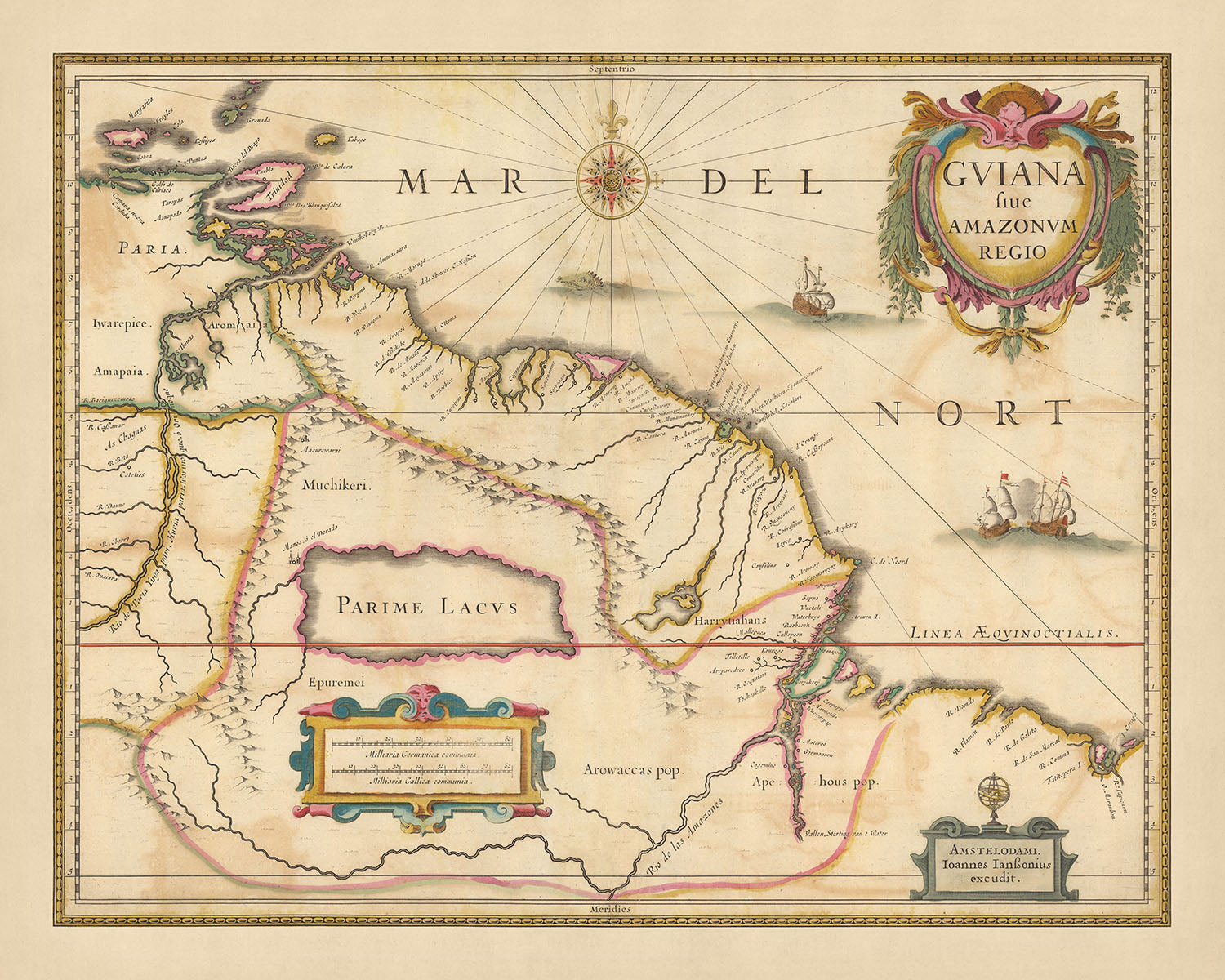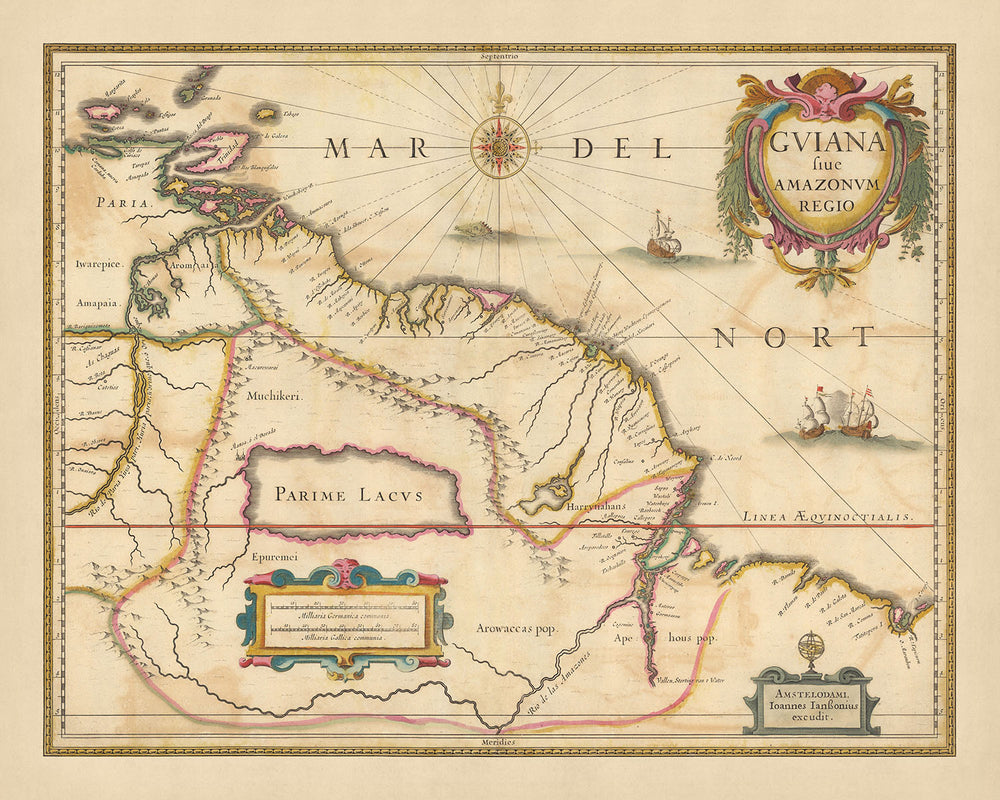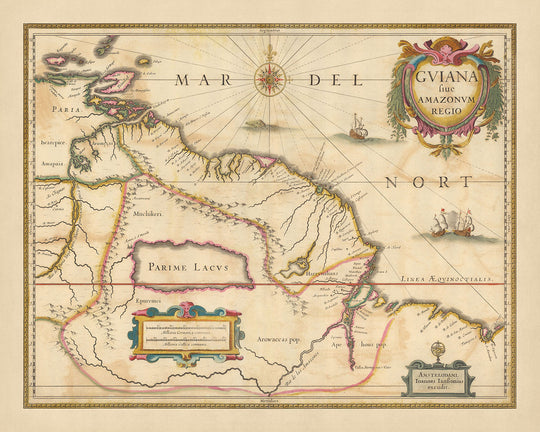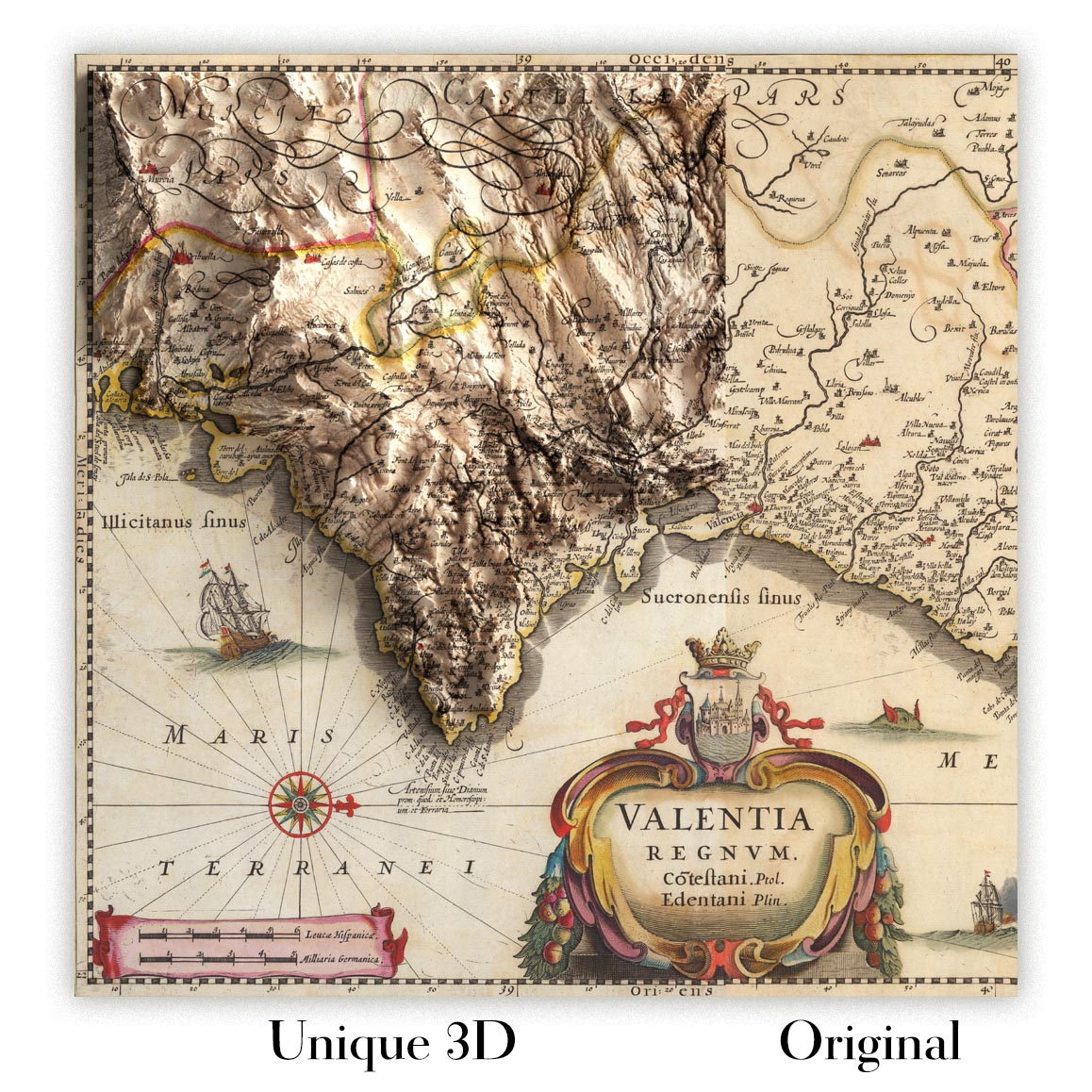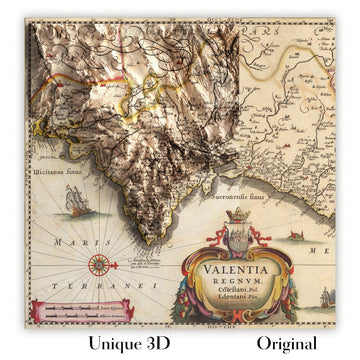- Handmade locally. No import duty or tax
- FREE Delivery by Christmas
- Love it or your money back (90 days)
- Questions? WhatsApp me any time
Own a piece of history
5,000+ 5 star reviews


Experience the grandeur of the 17th century with our meticulously detailed map, 'Guiana siue Amazonum regio', crafted by the renowned Dutch cartographer, Nicolaes Visscher II. This exquisite piece, dating back to 1690, presents an intricate view of Guiana and the Amazon region, which are parts of the larger modern-day South America. The English translation of the map's name is 'Guiana or Region of the Amazons', signifying the areas it encompasses. Visscher, belonging to the illustrious lineage of the Visscher family, carries forward the legacy of the Dutch Golden Age of cartography, making this map a significant artifact in the history of map-making.
The map features several cities and landmarks that are of historical and geographical importance. These include Trinidad and Tobago, Suriname, Amapá, Pará, and Guyana. The map's extensive detailing allows the viewer to discern the different regions and political divisions of the time. It provides a unique perspective on the world as it was known in the 17th century, making it a fascinating piece for history enthusiasts and collectors alike.
The map is hand-colored in outline and engraved, showing administrative boundaries, cities, towns, waterways, canals, and mountains. It includes decorative cartouches and a vignette of a ship, adding to its aesthetic appeal. A sea battle on the ocean is also depicted, providing a glimpse into the maritime history of the era. The relief is shown pictorially, adding depth and dimension to the map, and making it a truly immersive piece.
This map is not just a geographical representation, but a work of art that tells a story. It captures the essence of an era marked by exploration and discovery. It is a testament to the skill and craftsmanship of Nicolaes Visscher II, and a tribute to the Dutch Golden Age of cartography. This piece is sure to be a conversation starter, adding a touch of historical elegance to any setting. It is a perfect addition to the collection of any map enthusiast, history buff, or connoisseur of fine art.
Some of the significant locations shown on this map:
Guiana:
- Georgetown (Founded in 1781 as Stabroek, renamed Georgetown in 1812): The capital of Guyana, it is notable for its British colonial architecture.
- New Amsterdam (Founded in 1740): A historic town in Guyana, known for its Dutch colonial architecture.
- Bartica (Established in 1842): Known as the "Gateway to the Interior", it's the launching point for people who work in the rainforests.
Suriname:
- Paramaribo (Founded in 1613): The capital and largest city of Suriname, it's known for its Dutch colonial buildings.
- Nieuw Amsterdam (Founded in 1740): A historic town in Suriname, it was a former Dutch colonial settlement.
Amapá:
- Macapá (Founded in 1688): The capital of Amapá, it's known for the Fortaleza de São José de Macapá, a historic Portuguese colonial fort.
Pará:
- Belém (Founded in 1616): The capital and largest city of Pará, it's known for its colonial-era architecture.
- Santarém (Founded in 1661): Known as the "Pearl of the Tapajós", it's located at the confluence of the Tapajós and Amazon rivers.
Trinidad and Tobago:
- Port of Spain (Founded in 1560): The capital city of Trinidad and Tobago, it's known for its Carnival, one of the world's largest and most famous.
- San Fernando (Founded in 1595): The second largest city of Trinidad and Tobago, it's known for its sugar cane industry.
Notable natural attractions:
- The Amazon Rainforest: The world's largest tropical rainforest, it's a major center of biodiversity.
- The Orinoco River: One of the longest rivers in South America, it's known for its diverse wildlife.
- The Essequibo River: The largest river in Guyana, it's known for its rapids and waterfalls.
- The Kaieteur National Park: Home to the Kaieteur Falls, one of the world's largest waterfalls.
- The Iwokrama Forest: A major center of biodiversity and eco-tourism in Guyana.
Historical events:
- The Dutch-Portuguese War (1602-1663): A conflict over colonial territories in Brazil and Africa.
- The Sugar Revolution (1640s-1680s): A major shift in the economy of the Caribbean from tobacco to sugar cane.
- The Treaty of Munster (1648): Ended the Eighty Years' War between Spain and the Dutch Republic, leading to the recognition of Dutch independence.
Please double check the images to make sure that a specific town or place is shown on this map. You can also get in touch and ask us to check the map for you.
This map looks great at all sizes: 12x16in (30.5x41cm), 16x20in (40.5x51cm), 18x24in (45.5x61cm), 24x30in (61x76cm), 32x40in (81.5x102cm), 40x50in (102x127cm), 48x60in (122x153cm) and 56x70in (142x178cm), but it looks even better when printed large.
I can create beautiful, large prints of this map up to 90in (229cm). Please get in touch if you're looking for larger, customised or different framing options.
The model in the listing images is holding the 16x20in (40.5x51cm) version of this map.
The fifth listing image shows an example of my map personalisation service.
If you’re looking for something slightly different, check out my collection of the best old maps of Europe and European cities to see if something else catches your eye.
Please contact me to check if a certain location, landmark or feature is shown on this map.
This would make a wonderful birthday, Christmas, Father's Day, work leaving, anniversary or housewarming gift for someone from the areas covered by this map.
This map is available as a giclée print on acid free archival matte paper, or you can buy it framed. The frame is a nice, simple black frame that suits most aesthetics. Please get in touch if you'd like a different frame colour or material. My frames are glazed with super-clear museum-grade acrylic (perspex/acrylite), which is significantly less reflective than glass, safer, and will always arrive in perfect condition.
This map is also available as a float framed canvas, sometimes known as a shadow gap framed canvas or canvas floater. The map is printed on artist's cotton canvas and then stretched over a handmade box frame. We then "float" the canvas inside a wooden frame, which is available in a range of colours (black, dark brown, oak, antique gold and white). This is a wonderful way to present a map without glazing in front. See some examples of float framed canvas maps and explore the differences between my different finishes.
For something truly unique, this map is also available in "Unique 3D", our trademarked process that dramatically transforms the map so that it has a wonderful sense of depth. We combine the original map with detailed topography and elevation data, so that mountains and the terrain really "pop". For more info and examples of 3D maps, check my Unique 3D page.
For most orders, delivery time is about 3 working days. Personalised and customised products take longer, as I have to do the personalisation and send it to you for approval, which usually takes 1 or 2 days.
Please note that very large framed orders usually take longer to make and deliver.
If you need your order to arrive by a certain date, please contact me before you order so that we can find the best way of making sure you get your order in time.
I print and frame maps and artwork in 23 countries around the world. This means your order will be made locally, which cuts down on delivery time and ensures that it won't be damaged during delivery. You'll never pay customs or import duty, and we'll put less CO2 into the air.
All of my maps and art prints are well packaged and sent in a rugged tube if unframed, or surrounded by foam if framed.
I try to send out all orders within 1 or 2 days of receiving your order, though some products (like face masks, mugs and tote bags) can take longer to make.
If you select Express Delivery at checkout your order we will prioritise your order and send it out by 1-day courier (Fedex, DHL, UPS, Parcelforce).
Next Day delivery is also available in some countries (US, UK, Singapore, UAE) but please try to order early in the day so that we can get it sent out on time.
My standard frame is a gallery style black ash hardwood frame. It is simple and quite modern looking. My standard frame is around 20mm (0.8in) wide.
I use super-clear acrylic (perspex/acrylite) for the frame glass. It's lighter and safer than glass - and it looks better, as the reflectivity is lower.
Six standard frame colours are available for free (black, dark brown, dark grey, oak, white and antique gold). Custom framing and mounting/matting is available if you're looking for something else.
Most maps, art and illustrations are also available as a framed canvas. We use matte (not shiny) cotton canvas, stretch it over a sustainably sourced box wood frame, and then 'float' the piece within a wood frame. The end result is quite beautiful, and there's no glazing to get in the way.
All frames are provided "ready to hang", with either a string or brackets on the back. Very large frames will have heavy duty hanging plates and/or a mounting baton. If you have any questions, please get in touch.
See some examples of my framed maps and framed canvas maps.
Alternatively, I can also supply old maps and artwork on canvas, foam board, cotton rag and other materials.
If you want to frame your map or artwork yourself, please read my size guide first.
My maps are extremely high quality reproductions of original maps.
I source original, rare maps from libraries, auction houses and private collections around the world, restore them at my London workshop, and then use specialist giclée inks and printers to create beautiful maps that look even better than the original.
My maps are printed on acid-free archival matte (not glossy) paper that feels very high quality and almost like card. In technical terms the paper weight/thickness is 10mil/200gsm. It's perfect for framing.
I print with Epson ultrachrome giclée UV fade resistant pigment inks - some of the best inks you can find.
I can also make maps on canvas, cotton rag and other exotic materials.
Learn more about The Unique Maps Co.
Map personalisation
If you're looking for the perfect anniversary or housewarming gift, I can personalise your map to make it truly unique. For example, I can add a short message, or highlight an important location, or add your family's coat of arms.
The options are almost infinite. Please see my map personalisation page for some wonderful examples of what's possible.
To order a personalised map, select "personalise your map" before adding it to your basket.
Get in touch if you're looking for more complex customisations and personalisations.
Map ageing
I have been asked hundreds of times over the years by customers if they could buy a map that looks even older.
Well, now you can, by selecting Aged before you add a map to your basket.
All the product photos you see on this page show the map in its Original form. This is what the map looks like today.
If you select Aged, I will age your map by hand, using a special and unique process developed through years of studying old maps, talking to researchers to understand the chemistry of aging paper, and of course... lots of practice!
If you're unsure, stick to the Original colour of the map. If you want something a bit darker and older looking, go for Aged.
If you are not happy with your order for any reason, contact me and I'll get it fixed ASAP, free of charge. Please see my returns and refund policy for more information.
I am very confident you will like your restored map or art print. I have been doing this since 1984. I'm a 5-star Etsy seller. I have sold tens of thousands of maps and art prints and have over 5,000 real 5-star reviews. My work has been featured in interior design magazines, on the BBC, and on the walls of dozens of 5-star hotels.
I use a unique process to restore maps and artwork that is massively time consuming and labour intensive. Hunting down the original maps and illustrations can take months. I use state of the art and eye-wateringly expensive technology to scan and restore them. As a result, I guarantee my maps and art prints are a cut above the rest. I stand by my products and will always make sure you're 100% happy with what you receive.
Almost all of my maps and art prints look amazing at large sizes (200cm, 6.5ft+) and I can frame and deliver them to you as well, via special oversized courier. Contact me to discuss your specific needs.
Or try searching for something!







